Testing the Chemical/Structural Stability of Proton Conducting Perovskite Ceramic Membranes by in Situ/ex Situ Autoclave Raman Microscopy
Abstract
:1. Introduction
2. Results and Discussion
2.1. The High Temperature and High Pressure Autoclaves
| Autoclave | Volume (L) | Working conditions | Type of study |
|---|---|---|---|
| Ladir | 0.27 | RT-200 °C, 1–15 bar PH2O | protonation/aging test |
| Celeva (×2) | 0.125 | RT-315 °C, 1–100 bar PH2O | protonation/aging test |
| Heleva | 0.125 | RT-600 °C, 1–100 bar PH2O | protonation/aging test |
| in situ optic #1 | 0.05 | RT-620 °C, 1–50 bar PH2O | protonation/aging tests followed in situ by Raman scattering |
| in situ optic #2 | 0.05 | RT-500 °C, 1–30 bar PH2O or PCO2, electric field | protonation/aging tests followed in situ by Raman scattering with or without electric field |
2.1.1. Autoclaves
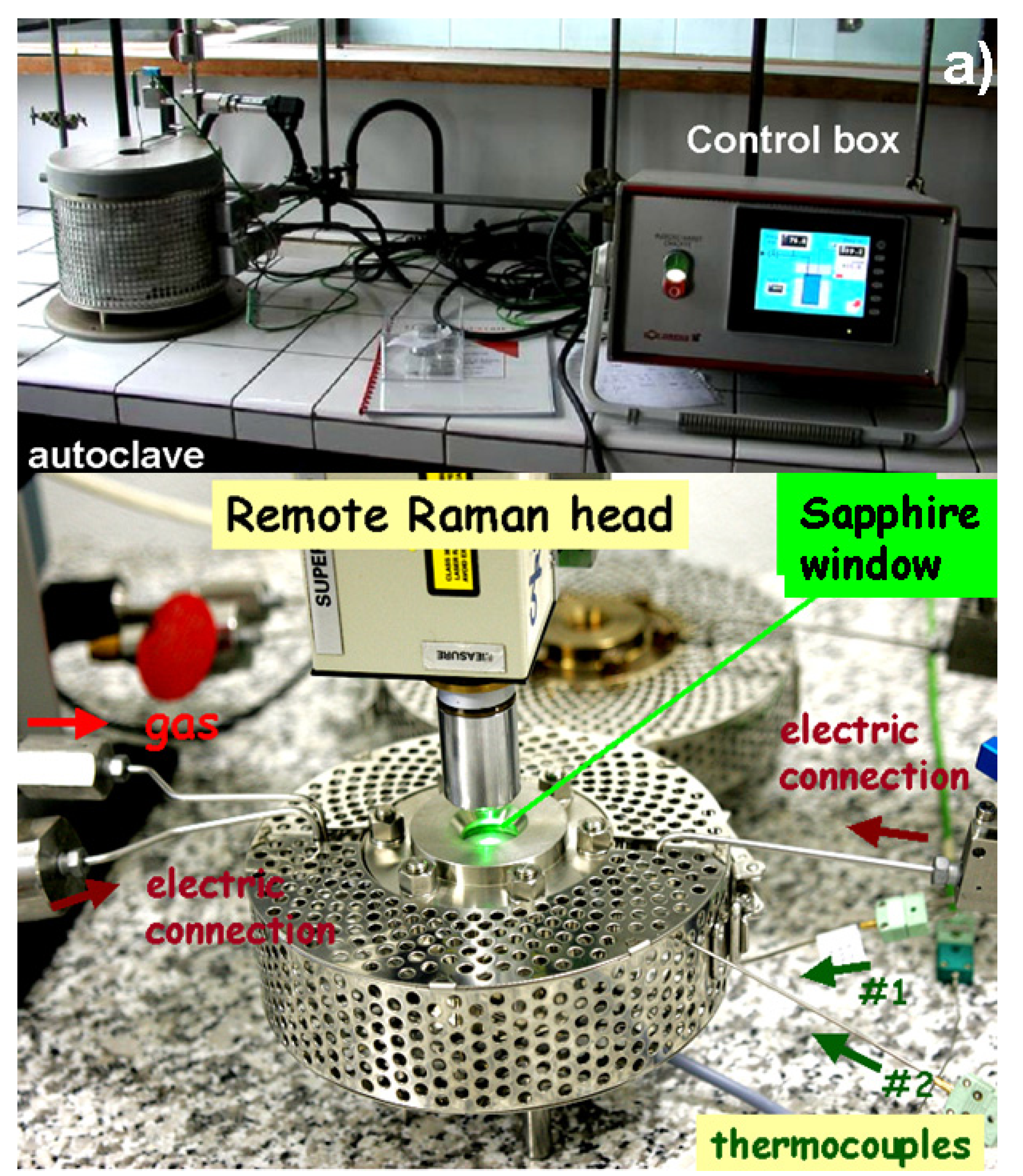
2.1.2. Raman in Situ Autoclaves
2.2. The Study of Chemical and Structural Stability of Proton-Conducting Perovskite Membranes
2.2.1. Characterization of Non-Protonated Ceramics
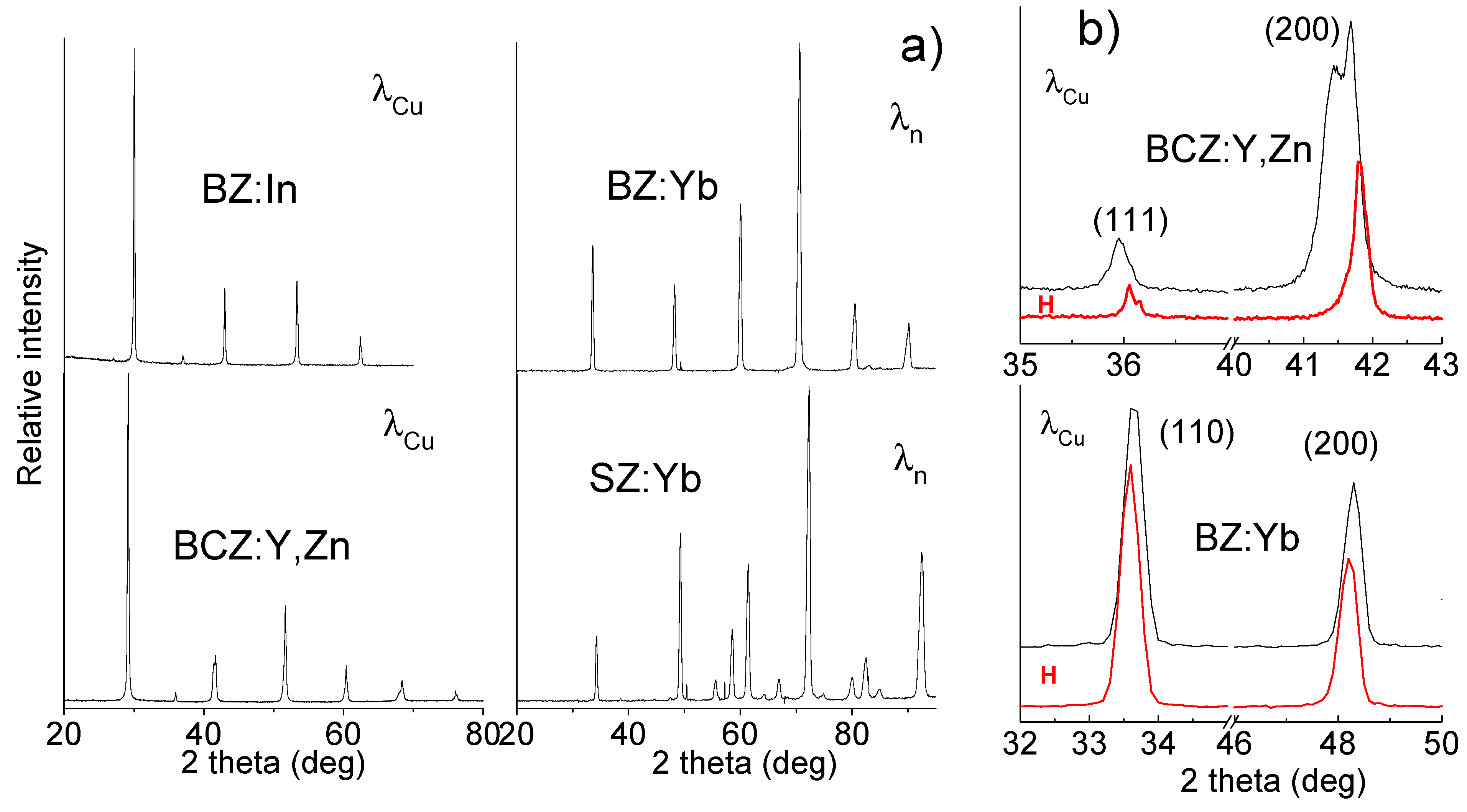

| Compound | BCZ:Y,Zn | BZ:In | BZ:Yb | SZ:Yb |
|---|---|---|---|---|
| Composition | BaCe0.5Zr0.3Y0.16Zn0.04O3−δ | BaZr0.25In0.75O3−δ | BaZr0.9Yb0.1O3−δ | SrZr0.9Yb0.1O3−δ |
| State before treatment | High density (97%) ceramic pellet, middle brown | Dense (90%) ceramic pellet, light brown | High density (97%) ceramic pellet, middle brown | High density (98%) ceramic pellet, middle brown |
| Autoclave Treatment | 500 °C/10 bar H2O/30 h | 300 °C/80 bar H2O/5 days | 200 °C/15 bar H2O/23 days | 200 °C/15 bar H2O/5–23 days OR 500 °C/80 bar H2O/5 days |
| Habit | Surface slightly crumbled | Total ceramic crumbling | Surface slightly crumbled | Thin surface layer OR no change |
| Structural/chemical changes | Coexistence of perovskite phase and BaCO3, CeO2, Ba(OH)2·H2O →Partial decomposition | BaCO3, ZrO2, Ba(OH)2·H2O, In2O3 →Total decomposition | Coexistence of perovskite phase and traces of BaCO3, Ba(OH)2·H2O →Partial decomposition of surface—Bulk OK | Traces of SrCO3, and Sr(OH)2·H2O on the surface |
| Symmetry (non –H) | Distorted rhombohedral & multiphased | Distorted cubic | Cubic | Orthorhombic |
| Symmetry (H) | Cubic | Decomposition | Cubic | Orthorhombic |
| Decomposition rate | ~30 µm/day | >150 µm/day | ~10 µm/day | <0.25 µm/day |

2.2.2. Protonated Ceramics

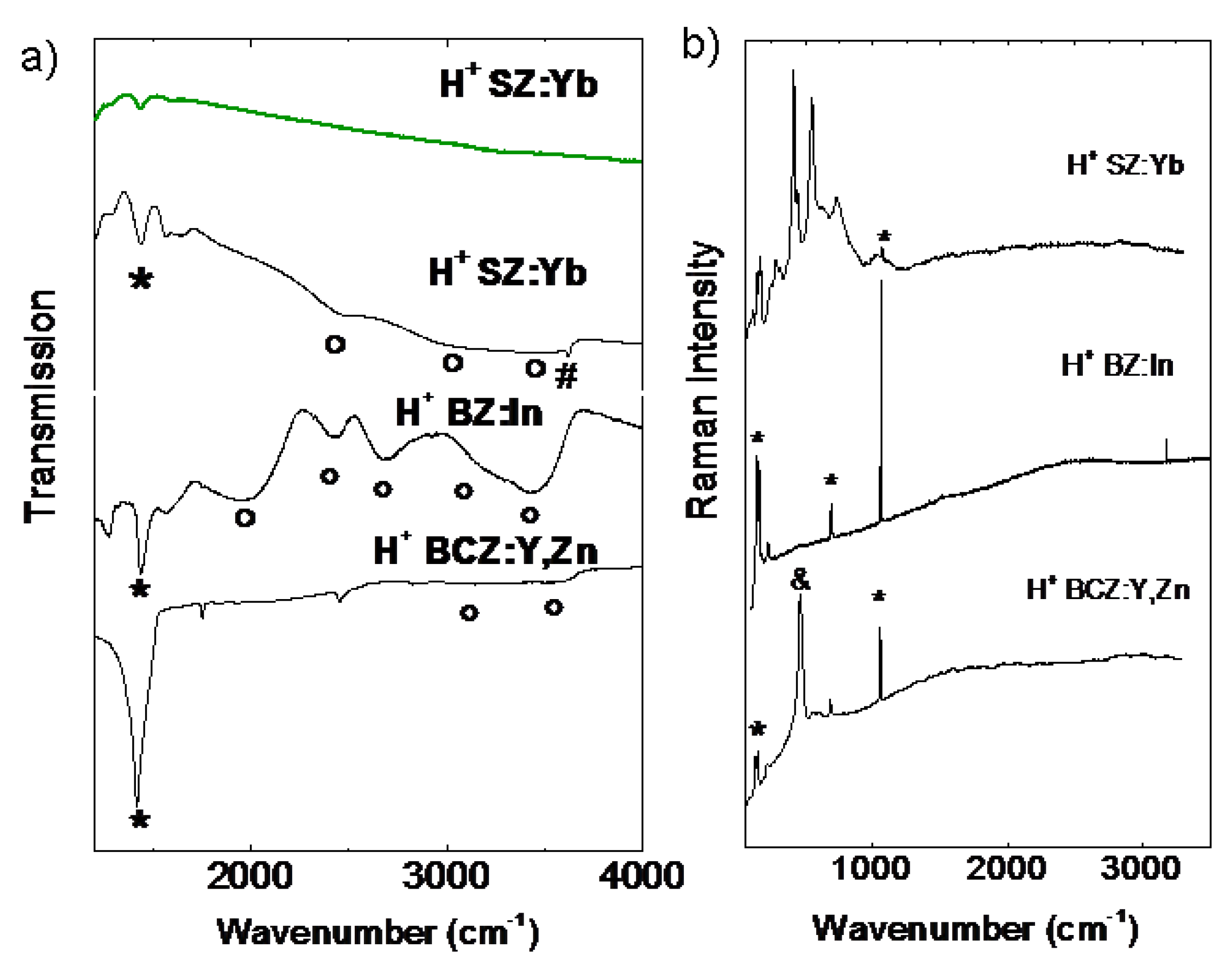
2.2.3. In Situ Monitoring of Protonation/Operating—Stability Test
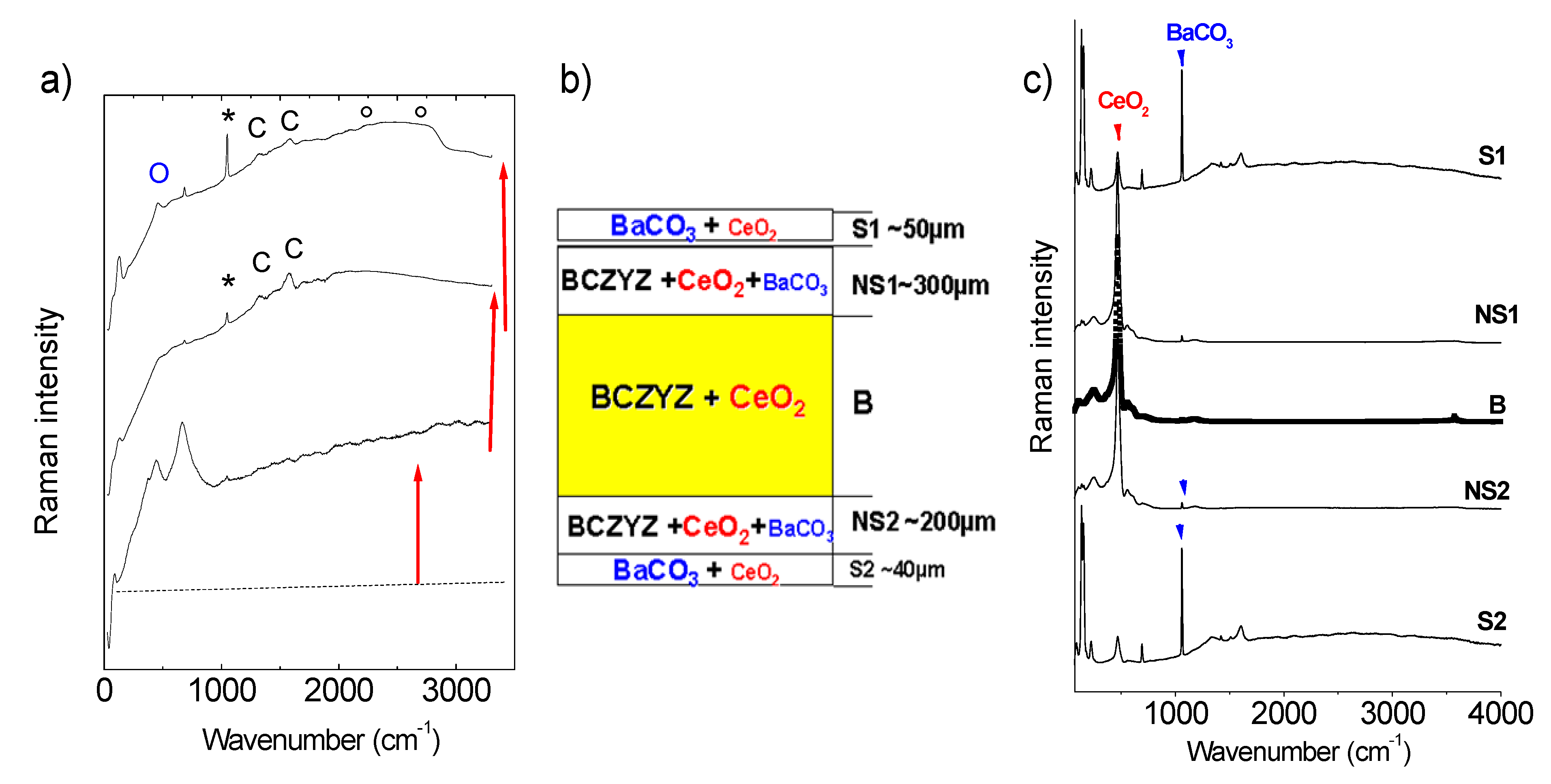
2.3. Corrosion Rate and Mechanisms

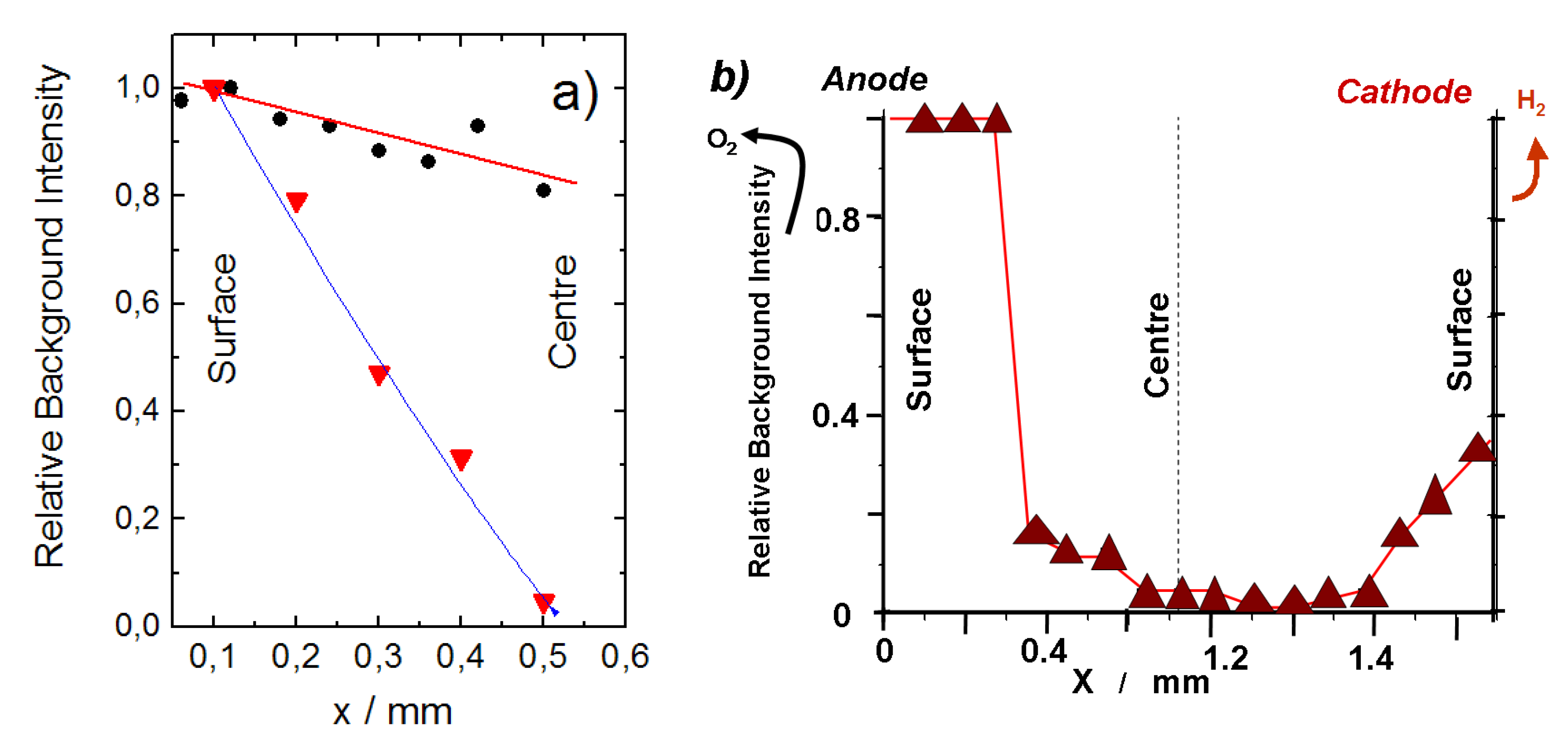
2.4. Towards Analysis of Electrochemical Dispositive
3. Experimental Section
4. Conclusions
Acknowledgments
Conflicts of Interest
References
- Forrat, F.; Dauge, G.; Trevoux, P.; Danner, G.; Christan, M. Electrolyte solide a base de AlLaO3 application aux piles à combustible. Acad. Sci. Paris 1964, 259, 2813–2816. (in French). [Google Scholar]
- Iwahara, H.; Esaka, T.; Uchida, H.; Maeda, N. Proton conduction in sintered oxides and its application to steam electrolysis for hydrogen production. Solid State Ion. 1981, 3/4, 359–363. [Google Scholar]
- Colomban, Ph. Proton Conductors Solids, Membranes and Gel—Materials and Devices; Cambridge University Press: Cambridge, UK, 1992. [Google Scholar]
- Olah, G.A. Beyond oil and gas: The methanol economy. Angew. Chem. Int. Ed. 2005, 44, 2636–2649. [Google Scholar]
- Ni, M.; Leung, M.K.H.; Leung, D.Y.C. Energy and energy analysis of hydrogen production by solid oxide steam electrolyser plant. Int. J. Hydrog. Energy 2007, 32, 4648–4660. [Google Scholar]
- Matsumoto, H.; Okada, S.; Hashimoto, S.; Sasaki, K.; Yamamoto, R.; Enoki, M.; Ishihara, T. Hydrogen separation from Syngas using high-temperature proton conductors. Ionics 2007, 13, 93–99. [Google Scholar]
- Blum, P.; Deportes, C.; Schouler, E. Production d’hydrogène par réduction électrochimique de la vapeur d’eau à haute température. Rev. Générale d’Electr. 1976, 85, 1–11. (in French). [Google Scholar]
- Iwahara, H.; Uchida, H.; Yamasaki, I. High-temperature steam electrolysis using SrCeO3-based proton conductive solid electrolyte. Int. J. Hydrog. Energy 1987, 2, 73–77. [Google Scholar] [CrossRef]
- Kobayashi, T.; Abe, K.; Ukyo, Y.; Matsumoto, H. Study on current efficiency of steam electrolysis using a partial protonic conductor SrZr0.9Yb0.1O3−δ. Solid State Ion. 2001, 138, 243–251. [Google Scholar]
- Nowick, A.S.; Du, Y. High-temperature protonic conductors with perovskite-related structures. Solid State Ion. 1995, 77, 137–146. [Google Scholar]
- Kreuer, K.D. Proton-conducting oxides. Ann. Rev. Mater. Res. 2003, 33, 333–359. [Google Scholar] [CrossRef]
- Schober, T.; Bohn, H.G. Water vapour solubility and electrochemical characterization of the high temperature proton conductor SrZr0.9Y0.1O2.95. Solid State Ion. 2000, 127, 351–356. [Google Scholar] [CrossRef]
- Tao, S.; Irvine, J.T.S.; Kilner, J.A. An efficient solid oxide fuel cell based upon single-phase perovskites. Adv. Mater. 2005, 17, 1734–1742. [Google Scholar]
- Irvine, J.T.S.; Corcoran, D.J.D.; Lashtabeg, A.; Walton, J.C. Incorporation of molecular species into the vacancies of perovskite oxides. Solid State Ion. 2002, 154–155, 447–453. [Google Scholar]
- Ricote, S.; Bonanos, N.; Caboche, G. Water vapour solubility and conductivity study of the proton conductor BaCe(0.9−x)ZrxY0.1O3−δ. Solid State Ion. 2009, 180, 990–997. [Google Scholar]
- Norby, T. Proton conduction in solids: Bulk and interfaces. MRS Bull. 2009, 34, 923–928. [Google Scholar] [CrossRef]
- Colomban, Ph. Latest developments in proton conductors. Ann. Chim. Sci. Matér. Paris 1999, 24, 1–18. [Google Scholar]
- Malavasi, L.; Fisher, C.A.J.; Islam, M.S. Oxide-ion and proton conducting electrolyte materials for clean energy applications: Structural and mechanistic features. Chem. Soc. Rev. 2010, 39, 4370–4387. [Google Scholar] [CrossRef]
- Sala, B.; Lacroix, O.; Willemin, S.; Rhamouni, K.; Takenouti, H.; van der Lee, A.; Goeuriot, P.; Bendjeriou, B.; Colomban, Ph. Procédé d’Optimisation de la Conduction Ionique d’une Membrane Conductrice Ionique. (in French). WO Patent 2008/152317 A2, 18 December 2008. [Google Scholar]
- Sala, B.; Grasset, F.; Lacroix, O.; Sirat, A.; Rhamouni, K.; Keddam, M.; Takenouti, H.; Goeuriot, D.; Bendjeriou, B.; Colomban, Ph.; et al. Procédé de Génération d’hydrogène par électrolyse de Vapeur. (in French). French Patent FR 1159221, 12 November 2011. [Google Scholar]
- Communiqué de presse, CNRS. Vers une production massive et économique d’hydrogène. (in French). Available online: http://www2.cnrs.fr/presse/communique/1570.htm (accessed on 29 July 2013).
- Philibert, J.M. Atoms Movements: Diffusion and Mass Transport in Solids; EDP Sciences: Orsay, France, 1991. [Google Scholar]
- Colomban, Ph.; Slodczyk, A. The structural and dynamics neutron study of proton conductors: Difficulties and improvement procedures in protonated perovskite. Eur. Phys. J. Spec. Top. 2012, 213, 171–193. [Google Scholar] [CrossRef]
- Knauth, Ph.; di Vona, M.L. Solid State Proton Conductors: Properties and Applications in Fuel Cells; John Wiley & Sons: Chichester, UK, 2012. [Google Scholar]
- Colomban, Ph.; Zaafrani, O.; Slodczyk, A. Proton content and nature in perovskite ceramic membranes for medium temperature fuel cells and electrolysers. Membranes 2012, 2, 493–509. [Google Scholar] [CrossRef]
- Grimaud, A.; Bassat, J.M.; Mauvy, F.; Simon, P.; Canizares, A.; Rousseau, B.; Marrony, M.; Grenier, J.C. Transport properties and in-situ Raman spectroscopy study of BaCe0.9Y0.1O3−δ as a function of water partial pressures. Solid State Ion. 2011, 191, 24–31. [Google Scholar]
- Chen, Q.; Huang, T.W.; Baldini, M.; Hushur, A.; Pomjakushin, A.; Clark, S.; Mao, W.; Manghnani, M.; Braun, A.; Graule, T. The Effect of compressive strain on the raman modes of the dry and hydrated BaCe0.8Y0.2O3 proton conductor. J. Phys. Chem. C 2011, 115, 24021–24027. [Google Scholar] [CrossRef]
- Giannici, F.; Shirpour, M.; Longo, A.; Martorana, A.; Merkle, M.; Maier, J. Long-Range and short-range structure of proton-conducting Y:BaZrO3. Chem. Mater. 2011, 23, 2994–3002. [Google Scholar] [CrossRef] [Green Version]
- Tan, W.Y.; Zhong, Q.; Miao, M.S.; Qu, H.X. H2S Solid oxide fuel cell based on a modified Barium cerate perovskite proton conductor. Ionics 2009, 15, 385–388. [Google Scholar] [CrossRef]
- Dumortier, M.; Sanchez, J.; Keddam, M.; Lacroix, O. Energy transport inside a three-phase electrode and application to a proton-conducting solid oxide electrolysis cell. Int. J. Hydrog. Energy 2013, 38, 2610–2623. [Google Scholar] [CrossRef]
- Shimura, T.; Tanaka, H.; Matsumoto, H.; Yogo, T. Influence of the transition metal doping on conductivity of a BaCeO3-based protonic conductor. Solid State Ion. 2005, 176, 2945–2950. [Google Scholar] [CrossRef]
- Ricote, S.; Bonanos, N.; Marco de Lucas, M.C.; Caboche, G. Structural and conductivity study of the proton conductors BaCe(0.9−x)ZrxY0.1O3−δ. J. Power Sources 2009, 193, 189–193. [Google Scholar] [CrossRef]
- Babilo, P.; Uda, T.; Haile, S.M. Proceesing of ytrium-doped barium zirconate for high proton conductivity. J. Mater. Res. 2007, 22, 1322–1330. [Google Scholar] [CrossRef]
- Chen, C.T.; Danel, C.E.; Kim, S. On the origin of blocking effect of grain boundaries on proton transport in yttrium doped barium zirconate. J. Mater. Chem. 2011, 21, 5435–5442. [Google Scholar] [CrossRef]
- Iguchi, F.; Sata, N.; Tsurui, T.; Yugami, H. Microstructure and grain boundary conductivity of BaZr1−xYxO3 ceramics. Solid State Ion. 2007, 178, 691–695. [Google Scholar]
- Dailly, J.; Marrony, M. BCY-based proton conducting ceramic cell: 1000 h of long term testing in fuel cell application. J. Power Sources 2013, 240, 323–327. [Google Scholar] [CrossRef]
- Slodczyk, A.; Colomban, Ph.; Willemin, S.; Lacroix, O.; Sala, B. Indirect Raman identification of the proton insertion in the high temperature [Ba/Sr][Zr/Ti]O3 modified perovskite protonic conductors. J. Raman Spectrosc. 2009, 40, 513–521. [Google Scholar] [CrossRef]
- Slodczyk, A.; Colomban, Ph.; André, G.; Zaafrani, O.; Grasset, F.; Lacroix, O.; Sala, B. Structural modifications induced by free proton in proton conducting perovskite ceramic membrane. Solid State Ion. 2012, 225, 214–218. [Google Scholar] [CrossRef]
- Slodczyk, A.; Colomban, Ph.; Lamago, D.; André, G.; Zaafrani, O.; Lacroix, O.; Sirat, A.; Grasset, F.; Sala, B. Optimum temperature range for the proton dynamics in H-doped BaZrO3:Yb dense ceramics—A neutron scattering study. J. Mater. Res. 2012, 27, 1939–1949. [Google Scholar] [CrossRef]
- Colomban, Ph.; Slodczyk, A.; Lamago, D.; André, G.; Zaafrani, O.; Lacroix, O.; Willemin, S.; Sala, B. Proton dynamics and structural modifications in the protonic conductor perovskites. J. Phys. Soc. Jpn. 2010, 79, 1–16. [Google Scholar] [CrossRef]
- Slodczyk, A.; Limage, M.H.; Colomban, Ph.; Zaafrani, O.; Grasset, F.; Loricourt, J.; Sala, B. Substitution and proton doping effect on SrZrO3 behavior: High-pressure Raman study. J. Raman Spectrosc. 2011, 42, 2089–2099. [Google Scholar] [CrossRef]
- Colomban, Ph.; Tran, C.; Zaafrani, O.; Slodczyk, A. Aqua oxyhydroxycarbonate second phases at the surface of Ba/Sr-based proton conducting perovskites: A source of confusion in the understanding of proton conduction. J. Raman Spectrosc. 2013, 44, 312–320. [Google Scholar] [CrossRef]
- Slodczyk, A.; Zaafrani, O.; Colomban, Ph. High water pressure–high temperature autoclave for in situ Raman study of fuel cell/electrolyser materials. MRS Proc. 2012, 1385. mrsf11–1385-c02–03. [Google Scholar] [CrossRef]
- Tu, C.-S.; Chien, R.R.; Schmidt, V.H.; Lee, S.C.; Huang, C.-C. Temperature-dependent structures of proton-conducting Ba(Zr0.8−xCexY0.2)O2.9 ceramics by Raman scattering and X-ray diffraction. J. Phys. Condens. Matter 2012, 24, 155403. [Google Scholar] [CrossRef]
- Pasto, A.E.; Condrate, R.A. The laser Raman spectra of several perovskite zirconates. In Advanced Spectroscopy; Mathieu, J.P., Ed.; Heyden & Sons Ltd.: London, UK, 1973; Chapter 24; pp. 196–203. [Google Scholar]
- Genet, F.; Loridant, S.; Lucazeau, G. Vibrational normal modes of the D-2h(16) phase of BaCeO3: A critical comparison of force fields. J. Raman Spectrosc. 1997, 28, 255–276. [Google Scholar] [CrossRef]
- Slodczyk, A.; Colomban, Ph. Probing the nanodomain origin and phase transition mechanisms in (Un)Poled PMN-PT single crystals and textured ceramics. Materials 2010, 3, 5007–5028. [Google Scholar] [CrossRef]
- Zelenovskiy, P.S.; Fontana, M.D.; Shur, V.Y.; Bourson, P.; Kuznetsov, D.K. Raman visualization of micro- and nanoscale domain structures in lithium niobate. Appl. Phys. A 2010, 99, 741–744. [Google Scholar] [CrossRef]
- Colomban, Ph.; Romain, F.; Neiman, A.; Animitsa, I. Double perovskites with oxygen structural vacancies: Raman spectra, conductivity and water uptake. Solid State Ion. 2001, 145, 339–347. [Google Scholar] [CrossRef]
- Gouadec, G.; Colomban, Ph. Raman Spectroscopy of nanomaterials: How spectra relate to disorder, particle size and mechanical properties. Prog. Cryst. Growth Charact. Mater. 2007, 53, 1–56. [Google Scholar] [CrossRef]
- Lucazeau, G. Effect of pressure and temperature on Raman spectra of solids: Anharmonicity. J. Raman Spectrosc. 2003, 34, 478–496. [Google Scholar] [CrossRef]
- Chemarin, C.; Rosman, N.; Pagnier, T.; Lucazeau, G. A high-pressure raman study of mixed perovskites BaCexZr1−xO3 (0 ≤ x ≤ 1). J. Solid State Chem. 2000, 149, 298–307. [Google Scholar] [CrossRef]
- Colomban, Ph.; Slodczyk, A. Raman intensity: An important tool to study the structure and phase transitions of amorphous/crystalline materials. Opt. Mater. 2009, 31, 1759–1763. [Google Scholar] [CrossRef]
- Slodczyk, A.; Dabrowski, B.; Malikova, N.; Colomban, Ph. Origins of rapid aging of Ba-based proton conducting perovskites. MRS Proc. 2011, 1311. mrsf10–1311-gg06–25. [Google Scholar] [CrossRef]
- Irvine, J.T.S.; Tao, S. A stable, easily sintered proton-conducting oxide electrolyte for moderate-temperature fuel cells and electrolysers. Adv. Mater. 2006, 18, 1581–1586. [Google Scholar] [CrossRef]
- Zaafrani, O. Protonation, Distorsions Structurales et espèces Protoniques Dans des Perovskites Lacunaires. Ph.D. Thesis, Université Pierre et Marie Curie, Paris, France, 20 December 2010. [Google Scholar]
- Bendjeriou-Sedjerari, B.; Loricourt, J.; Goeuriot, D.; Goeuriot, P. Sintering of BaZrO3 and SrZrO3 perovskites: Role of substitutions by yttrium or ytterbium. J. Alloy. Compd. 2011, 509, 6175–6183. [Google Scholar] [CrossRef]
- Slodczyk, A.; Sharp, M.D.; Upasen, S.; Colomban, Ph.; Kilner, J.A. Combined bulk and surface analysis of the BaCe0.5Zr0.3Y0.16Zn0.04O3−δ (BCZYZ) ceramic proton-conducting electrolyte. Solid State Ion. 2013. submitted for publication. [Google Scholar]
© 2013 by the authors; licensee MDPI, Basel, Switzerland. This article is an open access article distributed under the terms and conditions of the Creative Commons Attribution license (http://creativecommons.org/licenses/by/3.0/).
Share and Cite
Slodczyk, A.; Zaafrani, O.; Sharp, M.D.; Kilner, J.A.; Dabrowski, B.; Lacroix, O.; Colomban, P. Testing the Chemical/Structural Stability of Proton Conducting Perovskite Ceramic Membranes by in Situ/ex Situ Autoclave Raman Microscopy. Membranes 2013, 3, 311-330. https://doi.org/10.3390/membranes3040311
Slodczyk A, Zaafrani O, Sharp MD, Kilner JA, Dabrowski B, Lacroix O, Colomban P. Testing the Chemical/Structural Stability of Proton Conducting Perovskite Ceramic Membranes by in Situ/ex Situ Autoclave Raman Microscopy. Membranes. 2013; 3(4):311-330. https://doi.org/10.3390/membranes3040311
Chicago/Turabian StyleSlodczyk, Aneta, Oumaya Zaafrani, Matthew D. Sharp, John A. Kilner, Bogdan Dabrowski, Olivier Lacroix, and Philippe Colomban. 2013. "Testing the Chemical/Structural Stability of Proton Conducting Perovskite Ceramic Membranes by in Situ/ex Situ Autoclave Raman Microscopy" Membranes 3, no. 4: 311-330. https://doi.org/10.3390/membranes3040311





